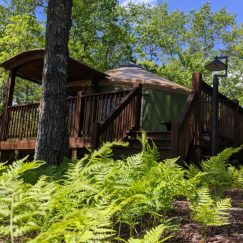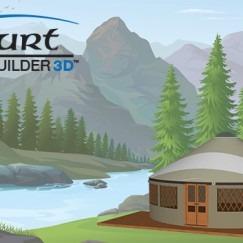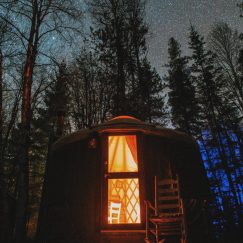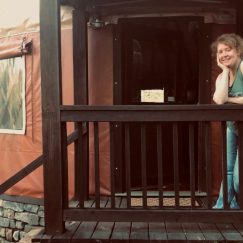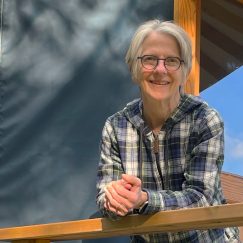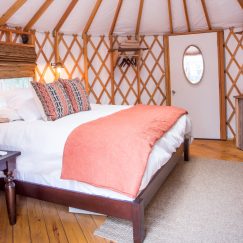The Chronicle: Business ‘without corners’ carves out line of success
This article is republished with permission from The Chronicle and author Dana Merryday. The article can be found here. Pacific Yurts is grateful to Dana and The Chronicle for this wonderful feature!
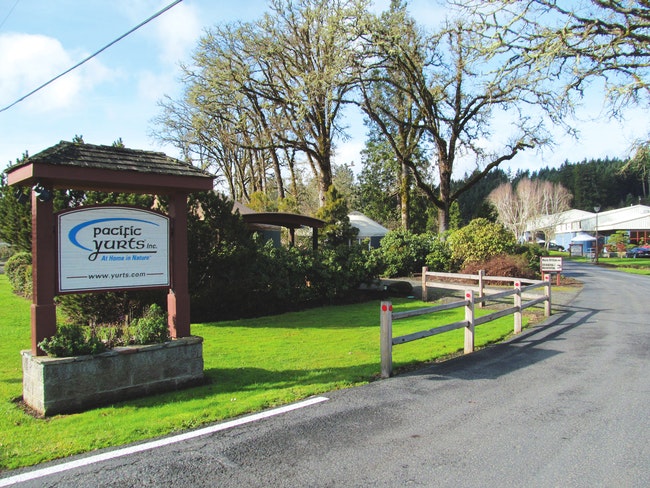
Alan Bair never intended to start a company or a movement.
Then one day, he read an article on yurts in National Geographic detailing how nomadic sheepherders created one of the most efficient surface-to-volume ratio structures by using very lightweight natural materials.
His curiosity was piqued.
He didn’t intend to start a movement, but 43 years later Bair has made Cottage Grove Ground Zero in the western production of these ancient dwellings.
Nestled among the trees a couple of miles south of Cottage Grove on Highway 99 are a cluster of dome-shaped dwellings and the world headquarters for Pacific Yurts. It is here that most of the structural elements of this new-old dwelling are manufactured. All of the elements are then brought together, packaged, and shipped out all over the world.
Yurts have been dwellings of the nomadic people of Mongolia and northern east Asia since before written history. The traditional herders covered their yurts with felt pads made from their animal’s wool for insulation and animal hides for a waterproof covering. Similar structures are still found in parts of Turkey and Hungary thanks to Genghis Khan, who traveled with a huge yurt mounted on a wagon and pulled by 22 oxen.
The shape allows wind to flow around it rather than resisting it. Being light and easily portable with pack animals made it perfect for moving the structure to fresh pastures for their herds, and the use of lightweight materials make this traditional design highly-efficient and sturdy.
Bair figured out how to build one for himself in the mid-1970s. This yurt came in handy when he was living in the woods in Cottage Grove when he was a contractor for tree planting. Later Bair and his wife, Chandra, lived in a yurt while they built their home on undeveloped land.
It became clear to Bair that there was a market out there for this simple structure. Friends who helped him build the original yurt wanted their own. A reporter got wind of the yurts, and that story led to calls from people wanting help in building their own from all over.
In 1978, Pacific Yurts was formed, originally with two partners. The first factory floor was in an old dairy barn in Creswell. The barn was cold and drafty but had the room to tinker and perfect the yurt designs.
This barn served as an incubator of small businesses as they shared resources and ideas. The budding yurt business shared the barn with two other small Oregon businesses which were also just getting started. One of them, Burley Bike Bags, was contracted to sew yurt covers made from marine-grade canvas.
As things began to heat up with the yurt business, electrical power needs and other issues, in 1980, Pacific Yurts pulled up stakes in Creswell and moved to its current location south of Cottage Grove near Weyerhaeuser.
They rented an old frame building that had seen many other enterprises, including an auto repair shop, and surprisingly, considering the building’s size, a roller skating rink. There was lots of room on the property to expand the operations, which would come in handy in due time.
Bair eventually bought the building and the three-acre property. The old frame building was too old, cramped and failing structurally, so it was replaced by a larger, modern structure further back on the property. This dramatic move “across the stream,” allowed Pacific Yurts to up production and plan for expansion.
One of the core principles of Pacific Yurts has been the concern and care for the environment. This belief guided the development of the property and the product. Careful planning allowed them to preserve the old growth oak savannah on the property and minimize the impact on the land. Conscientious landscaping adds beauty and wildlife habitat to the operation.
Respect for land is in the bones of the yurt itself. It is by definition a low-impact environmentally-friendly product. Yurts can be placed in the wilderness by delivering the pieces in the back of a pick-up truck, trailer, or in a few cases, by ATV or helicopter.
Pacific Yurts uses second-growth wood from sustainably managed forests, minimizing waste, and reuses all scraps and pieces, pre-cycle and use green power and soy inks. Using minimal materials to create maximum space, its portability and its ability to leave virtually no trace, the yurt is a light touch on the Earth.
In last week’s issue we learned how local-born Pacific Yurts came into being. This week we are going to see how far they have come and where they are going.
Happy employees are a key feature of Pacific Yurts’ success story. The company employs 36 local folks. There is longevity on the staff, with many having been there 15, 20, or more years. Older employees mentor newer ones to help instill the expertise and attention to detail that has developed along with the continually evolving products.
There are two major parts of the yurt building team: the structural wood frame, and fabric-sewing production divisions. Each of these divisions uses techniques and expertise that has evolved along with the product. Special technologies were designed and patented specific to the unique work connected to yurt making.
These divisions are supported by an office staff, sales force, and a shipping and receiving team.
When Alan Bair was first getting the business going he would make lists of different uses for the yurts he was making. That list has grown over the years and many of the ideas came to him through inquiries from people looking for a different option than a traditional brick-and-mortar structure.
“People who wanted to get away and live on the land, have a guest house, needed temporary housing, a space for yoga and personal fitness, home office, retreat, or were just trying to avoid a mortgage, all found a yurt an attractive option,” Bair said. “A yurts uses are only limited by your imagination.”
Two other markets for yurts have opened up in addition to personal-use customers. One is state and local governments and the other is tourist and service-oriented businesses.
In 1993 Pacific Yurts received an inquiry from Oregon state parks about the feasibility of setting up a yurt at Cape Lookout State Park.
After being convinced that the yurts would be able to stand up to the windy coastal climate, the state purchased two yurts to try out. That original purchase was such a hit that the Oregon Parks system soon placed an order for 50 more.
That trend has continued so that today there are nearly 200 Pacific Yurts in state campgrounds all over Oregon. With Oregon weather, the cold, wet winter season effectively knocked out camping from October until April. By installing yurts the campgrounds could stay open year-round.
Parks were able to charge more to stay in a yurt than for a tent or RV site, bringing in a whole new clientele. In the July 1995 issue of the Nation’s Business magazine, an article reviewing this success story stated: “Say hello to the yurt, the biggest money maker to hit the Oregon State Parks since campsites were introduced to them 70 years ago.”
Many other states hopped on the bandwagon so that there are Pacific Yurts in nearly half of the nation’s state park systems.
It is not just public campgrounds that have figured out how to lure guests that might not go for roughing it in a tent or trailer. Many private campgrounds and youth camps have added yurts to their layout.
By using different-sized yurts grouped together it is fairly easy to create an attractive “yurt village” to rent for group stays. The yurts are easy to install without much clearing or disturbing the natural beauty of the site and can be easily relocated if necessary.
“Glamping” – glamour camping – is a term to describe the blending of the joys of camping with a comfortable and even luxurious stay despite rain, cold or insects. By setting up yurts with all the creature comforts including heat, bamboo floors, marble counters and other amenities like kitchens and bathrooms, guests can enjoy the sounds of nature and natural light that enters through the central skylight, while remaining very comfortable.
Campers get the best of both worlds. This style of camping is growing fast in popularity. It particularly appeals to folks who may have sold their RV, but still would like to spend a few days in the outdoors. A yurt can be perfect for them in combining comfort, accessibility to nature and security.
Guest journals left in the state park Pacific Yurts yield many ideas and feelings that make their way back to the company. One family expressed its gratitude for being able to take their wheelchair-bound father camping for the first time in many years. The accessibility of the yurt allowed him the joy of participating in what had long been a family tradition.
Ecotourism and adventure travel boosted the growth of yurts. The yurt’s low impact in environmentally sensitive areas fits into that vision. The relative low cost and the ability to deliver a yurt kit into difficult-to-reach sites adds to the appeal of using yurts to get people into unique natural areas.
Ski areas have also turned to yurts to provide for their guests. The special snow upgrade options that can be added to a yurt kit increase the load capacity, often exceeding the local structural codes. The kits can include a central support column, wooden supports and cables that add the strength to withstand heavy snowfalls and strong winds found in alpine settings.
Several innovations by Pacific Yurts have aided in their appeal to customers, both individual and in the hospitality industry. The clear acrylic dome allows natural light in, as does the solar arc roof option. A stove flashing allows the yurt to be heated by wood or gas stoves, and a snow and wind kit allows the yurt to be set up where it will encounter heavy snow conditions found at ski resorts and high altitude locations.
The most interesting option was suggested by a customer with aerospace industry connections. NASA had developed a reflective insulation that works much in the way a thermos does. The multiple-layered material is lightweight, flexible, and highly effective. It works primarily by reflecting radiant energy back toward its source. This means a yurt with the insulation and a heater installed can stay warm in cold environments. When it’s hot outside the sun’s heat is reflected off the yurt helping to keep it cooler inside. Ventilation through the central dome at the top of the yurt further allows temperature regulation and comfort in the yurt. This improvement has helped fuel an international market. Yurts are found from Alaska to the Caribbean and in all climates in between.
While touring the “display model” yurts at the company headquarters it was very inspiring to see what was possible to do to the interior of a yurt. By making the wooden platform that the yurt rests on with enough clearance or crawl space, plumbing, ducted heating, and other conveniences can be brought into the yurt. Erecting partial walls gives privacy for bathrooms or other spaces such as kitchens or closets. It is all possible. Extending out from the platform can yield decks, porches and covered entrances. Only the owner’s imagination and budget can limit what one can do to the inside of the yurt. One very impressive aspect is the open, light-filled, spacious feeling created by the structural elements of the yurt itself.
Covid has affected a few of the ways Pacific Yurts does its business. The office has been closed to the public. Instead, a small yurt has been set up out in front of the headquarters so that sales people can meet interested clients and still socially distance. A small space heater along with the NASA insulation keep the yurt very comfortable. Business has actually increased during the pandemic as restaurants and other hospitality businesses have discovered that yurts can provide the option of offering fine dining outside. The St. Regis Deer Valley, Park City, Utah, opened its Yurt Village this past December. Other clients, forced to work at home by the virus, have turned to Pacific Yurts to have a home office or a retreat to self-isolate.
In the 40-plus years of operation in the Cottage Grove area, Pacific Yurts has given back to the community. Through donations to many local causes and supporting efforts to make this a great place to live, work and raise a family. An unseen benefit to the larger community is the economic impact of the company. Many of the materials and supplies used in yurt production have been sourced in Oregon, while others may not be from Oregon, but are made in the U.S.
“It is like the movie “A Field of Dreams,” if you build it, they will come. We have had many people who are interested in our yurts plan their vacations to come visit the model yurts set up at our campus. It is very exciting when you have a passion for your product, a great staff, and can interact with your customers in a very positive way. This has been and continues to be an adventure that can make a big difference in people’s lives,” Bair said of his life’s work.
There are people all over the country and the world who may not know much about our region, but they do know where to get a unique, Earth-friendly, solution to their living structure needs. An old technology brought into the modern age and still evolving, right here at Pacific Yurts.
